|
|
|
Sort Order |
|
|
|
Items / Page
|
|
|
|
|
|
|
| Srl | Item |
| 1 |
ID:
139552
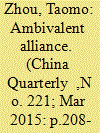

|
|
|
|
|
| Summary/Abstract |
From 1960 until 1965, the People's Republic of China (PRC) built a remarkably cordial quasi alliance with the Republic of Indonesia. At the same time, however, the years between 1960 and 1965 were marked by two large waves of anti-Chinese movements in Indonesia. Although more than half a century has passed since these events, our understanding of Chinese foreign policy towards Indonesia during these turbulent years remains incomplete. In 2008, the Chinese Foreign Ministry Archives declassified for the first time documents produced during the years between 1961 and 1965. However, very recently in summer 2013, the Chinese Foreign Ministry Archives re-classified the main body of its collection. Through examining this body of fresh but currently inaccessible official records, this article aims to bridge the gap between scholarly works on the PRC's diplomatic history and overseas Chinese history. By tracing the processes by which Chinese diplomats dealt with Sukarno, the ethnic Chinese in Indonesia, and the Communist Party of Indonesia (Partai Komunis Indonesia, or the PKI), this article argues that the ambivalent Chinese alliance with Indonesia was shaped by three disparate pressures which interacted and competed with one another: the strategic need to befriend Third World countries, ethnic ties to the Chinese in Indonesia and ideological commitment to the international communist movement.
|
|
|
|
|
|
|
|
|
|
|
|
|
|
|
|
| 2 |
ID:
133739
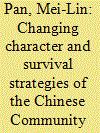

|
|
|
|
|
| Publication |
2014.
|
| Summary/Abstract |
The Chinese community has been settled in India for more than two centuries. Its relationship to the host society and to the authorities, first British and then Indian, has gone through different stages with different forms. It is important to examine the lives, traditions and attitudes of the Chinese community to understand its development and its changing character. This study argues that it is misleading to present this community as one that has always been marginalised and discriminated against in India. It examines the applicability of concepts such as 'sojourning', 'corridors' and 'middleman minority' to the community and its different sub-groups, both in British India and in post-independence India.
|
|
|
|
|
|
|
|
|
|
|
|
|
|
|
|
| 3 |
ID:
106014
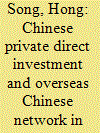

|
|
|
|
|
| Publication |
2011.
|
| Summary/Abstract |
Based on extensive interviews in China and in Africa over 2 years, the present paper investigates Chinese private direct investment in Africa. Drawing on the Swedish Uppsala model, we explore two mian issues. First, do Chinese private enterprises follow the linear mode to invest in Africa? Second, if not, how do they go out and develop their investments, and who helps them overcome the obstacles to investing in Africa? We find that very few Chinese private enterprises follow a linear internationalization process, and most depend on the local overseas Chinese network and other networks to facilitate their entry into the host market. The reason lies in that Chinese private enterprises are still at the early stage of internationalization. Entrepreneurship is one of the most important ownership advantages of Chinese private enterprises investing in Africa.
|
|
|
|
|
|
|
|
|
|
|
|
|
|
|
|
| 4 |
ID:
192659
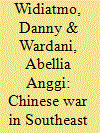

|
|
|
|
|
| Summary/Abstract |
Kokang is an ethnic minority group that settled along the Myanmar-China borderland with dual identity as it has long historical ties of nationalism and patronage with various political factions in China while located outside China’s border. This article explores how Kokang’s Ethnic Revolutionary Organization (ERO), the Myanmar National Democratic Alliance Army, and their leaders construct Kokang’s identity to their benefit. Based on desk research method, the article found that Kokang’s dual identity allows them to self-categorize themselves as Chinese or separate-independent ethnic minorities in Myanmar while setting ethnic boundaries with various political entities to protect their interest.
|
|
|
|
|
|
|
|
|
|
|
|
|
|
|
|
| 5 |
ID:
107316
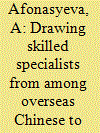

|
|
|
|
|
| Publication |
2011.
|
| Summary/Abstract |
The article examines measures undertaken by the PRC leadership for drawing scientists and skilled specialists of Chinese origin from abroad to China with a view to reducing the shortage of skilled personnel on the labor market. Problems facing the Chinese coming back to the country of their origin are discussed. The article analyzes the Russian and Chinese experience of drawing labor resources from among expatriates living abroad. The author comes to a conclusion that it would be quite expedient for Russia to use certain Chinese experience in this sphere.
|
|
|
|
|
|
|
|
|
|
|
|
|
|
|
|
| 6 |
ID:
099702
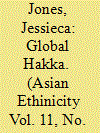

|
|
|
|
|
| Publication |
2010.
|
| Summary/Abstract |
This paper is based on a case study of a small group of Hakkas who have left the village-town of Beruas in the state of Perak on the west coast of the Malaysian Peninsula to make their homes overseas - mostly in cultures which are very different from the Hakka environment in which they grew up. It looks at: the reasons why they left their hometown; how they identify themselves in their new place of residence; who they married; their offspring in relation to the their mother tongue (Hakka) and traditions; how they see the future of 'Hakka culture' and the social and cultural costs of living overseas and marrying outside the dialect.
|
|
|
|
|
|
|
|
|
|
|
|
|
|
|
|
| 7 |
ID:
144764


|
|
|
|
|
| Summary/Abstract |
This article analyses the development of the governing mechanism in British Burma relating to one particular ethnic group, the Chinese, between the 1890s and 1920s. Recognizing its limited knowledge of China and the Chinese, British Burma relied in the early days on experiences from other colonies to govern its Chinese immigrants and to handle Sino-Burmese border issues. The transfer of colonial knowledge, however, proved insufficient when the state witnessed increasing localization at the turn of the twentieth century. Interlocutors and communal elites therefore replaced imperial expatriates to form the main governing body, and in turn to some extent undermined and reconstructed colonial knowledge, as well as practice.
|
|
|
|
|
|
|
|
|
|
|
|
|
|
|
|
| 8 |
ID:
153638
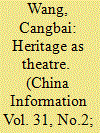

|
|
|
|
|
| Summary/Abstract |
Since China’s signing of UNESCO’s World Heritage Convention in 1985, cultural heritage in China has become a booming industry and a key area of scholarly investigation. The mainstream literature on China’s heritage and urbanization tends to view heritage as a civilizing agent to regulate and improve the urban population. Drawing on Clifford Geertz’s notion of ‘theatre state’ and through a case study of Jiangmen, this article reconceptualizes China’s urban heritage industry as ‘theatre’. It shifts the focus away from neat political rationalities to messy ‘magical assemblages’, such as dramatic museum representation, monumental architecture and expressive ceremonies, in state-led heritage-making processes. It argues that the Chinese government makes heritage by using not only the means of political rationalities but also, and perhaps more importantly, the power of spectacle, sensation and awe. China’s heritage industry is thus as much ‘a technique of enchantment’ as ‘a technique of government’, revealing complicated processes of China’s negotiation with the Western-centred conceptualization of modernity and cultural heritage. Additionally, it draws attention to diasporic resources in urban heritage-making, broadening the existing research that has predominantly focused on the employment of nostalgic and/or exotic appeal for city branding and development.
|
|
|
|
|
|
|
|
|
|
|
|
|
|
|
|
| 9 |
ID:
172443
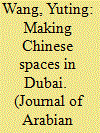

|
|
|
|
|
| Summary/Abstract |
This paper examines the spatial expansion of Chinese communities in the city of Dubai as the result of the strengthening economic ties between China and the Arab Gulf states over the last two decades and the diversification of economy in the Gulf region. Beginning with a brief account of the history of Chinese migration into the UAE, this paper sketches out the contour of Chinese spaces in a rapidly growing global city. This paper contributes to the development of a holistic assessment of the impact of China’s rise in the region and contextualizes the intricate relationships between China and the Arab World. It calls for more ethnographic studies of Chinese communities in the Arab Gulf states and emphasizes the need to broaden the traditional foci and methodology in the study of relations between China and these states.
|
|
|
|
|
|
|
|
|
|
|
|
|
|
|
|
| 10 |
ID:
168020
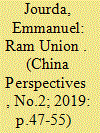

|
|
|
|
|
| Summary/Abstract |
The Ram Union is a non-profit social organisation established in 2003 in Zhejiang Province. Its transformation from a local entity into an international NGO tells us about the methods implemented by the Chinese Communist Party (CCP) to accompany the development of popular associations or minjian, which appear to be external to the Party but which in fact are fully sponsored by it. Studying such organisations is a complex matter, as they appear to act in a benevolent and apolitical manner, while being completely integrated within the political and social apparatus of the Party-state (Youth League, volunteers, United Front, ministry of Civil Affairs, etc.). The historical trajectory of the Ram Union thus gives us insight into the CCP’s overlooked strategy of hybridisation, involving mass organisations that came out of the revolutionary period and charitable groups embodying modern Chinese society. This strategy is designed to occupy the social arena and forestall the emergence of an autonomous Chinese civil society in the People’s Republic of China (PRC) or among the Chinese diaspora overseas.
|
|
|
|
|
|
|
|
|
|
|
|
|
|
|
|
| 11 |
ID:
181677
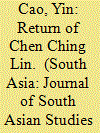

|
|
|
|
|
| Summary/Abstract |
During World War II, thousands of Chinese soldiers were sent to India for training. Many of them deserted from the army and made a new life in India. Chen Ching Lin was one of these deserters. Following the course of his journey in India from 1943 to 1946, this article not only unearths the little-known experiences of the Chinese deserters in India, but also explores how the Chinese Nationalist Government’s aim to discipline the overseas Chinese communities conflicted with the agenda of British geopolitics. It further contends that modern Chinese and Indian history could be integrated into a single narrative framework from subaltern perspectives.
|
|
|
|
|
|
|
|
|
|
|
|
|
|
|
|
| 12 |
ID:
193125
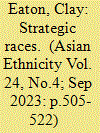

|
|
|
|
|
| Summary/Abstract |
This paper examines Japanese policies toward different races (minzoku) in Singapore during the Second World War. These policies, which victimized the Chinese community and appeared to favor others such as the Malay and Indian communities, fostered inter-racial resentments that would persist long after the war. Drawing on internal occupation guidelines produced by the Japanese state and the accounts of the administrators who implemented them, this paper shows that the treatment of the Chinese community was in fact a direct result of the perceived significance of these groups to the success or failure of Japan’s wartime imperial project in Southeast Asia. Groups whose importance the Japanese initially dismissed, however, had greater freedom to chart their own destinies and demand Japan live up to its promise of an “Asia for Asians” as the war progressed.
|
|
|
|
|
|
|
|
|
|
|
|
|
|
|
|
| 13 |
ID:
172997
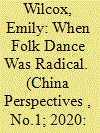

|
|
|
|
|
| Summary/Abstract |
This article challenges three common assumptions about Chinese socialist-era dance culture: first, that Mao-era dance rarely circulated internationally and was disconnected from international dance trends; second, that the yangge movement lost momentum in the early years of the People’s Republic of China (PRC); and, third, that the political significance of socialist dance lies in content rather than form. This essay looks at the transformation of wartime yangge into PRC folk dance during the 1950s and 1960s and traces the international circulation of these new dance styles in two contexts: the World Festivals of Youth and Students in Eastern Europe, and the schools, unions, and clan associations of overseas Chinese communities in Hong Kong, Singapore, Malaysia, and San Francisco. By tracing the emergence and circulation of yangge and PRC folk dance, I propose the existence of “Cold War yangge” – a transnational phenomenon in which Chinese folk dance became a site of leftist political activism.
|
|
|
|
|
|
|
|
|
|
|
|
|
|
|
|
|
|
|
|
|